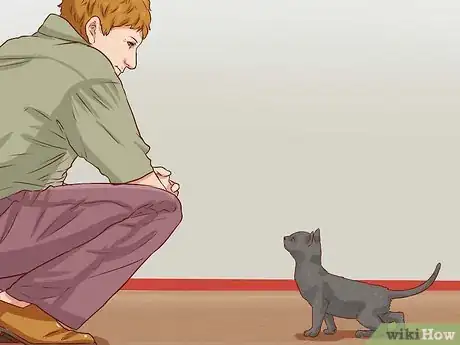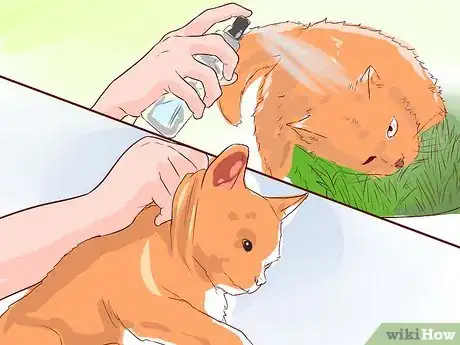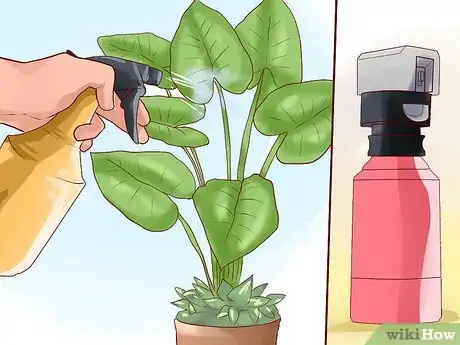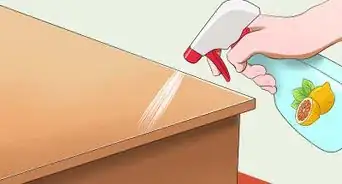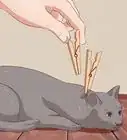This article was co-authored by Jessica Char. Jessica Char is a Cat and Dog Trainer, Behavior Consultant, and the Founder of Feline Engineering and Canine Engineering. She specializes in modifying challenging pet behavior problems, such as fear and aggression, using positive reinforcement training protocols. Jessica is a Certified Fear Free Trainer, a Certified Professional Dog Trainer, and a Certified Separation Anxiety Trainer. She is also a member of the International Association of Animal Behavior Consultants. Jessica received her BS and MS in Biomedical Engineering from Washington University in St. Louis.
There are 10 references cited in this article, which can be found at the bottom of the page.
This article has been viewed 219,022 times.
You feel like you are at your wit’s end because your cat just won’t stop scratching your furniture, urinating outside of her/his litter box, or doing some other undesirable behavior. You may be willing to try anything to get the bad behavior to stop, but it is important to realize that there are right ways and wrong ways to discipline your cat. You will need to discipline your cat in ways that will not only stop the bad behavior, but also keep your bond with her strong and intact.
Things You Should Know
- A misbehaving cat may have a medical problem or behavioral issues as the root cause.
- Some behaviors, like scratching furniture, are normal for a cat; to correct it, find an alternative for your cat to scratch.
- Bonding and spending time with your cat can help prevent it from acting out due to stress or boredom.
- Discipline your cat by making bad behavior difficult or unrewarding, and making good behavior very rewarding.
Steps
Learning Why Cats Misbehave
-
1Learn the medical reasons why cats demonstrate unwanted behavior. As much you might want to think that your cat is doing something bad simply out of spite, there may be a medical or behavioral reason why she’s doing what you don’t want her to do. For example, your cat may be going outside of the litter box because of a urinary problem (urinary tract infection, kidney disease) that keeps her from making it to the litter box in time. Your veterinarian will be able to determine if a medical problem is the root cause of the undesirable behavior. But also remember your cat may have a anxiety problem. [1]
- Pica is a medical issue that involves eating or chewing on inedible objects, like plastic or cardboard. If your cat is chewing on or eating unusual things, it may be a sign of dental or gastrointestinal disease.[2]
- Dementia could be causing your cat to cry at night.[3]
- Medical issues should be ruled out before behavioral issues are considered.
-
2Learn the behavioral issues that could be causing your cat’s bad behavior. If your veterinarian has been able to rule out medical causes of bad behavior, then it is time to start looking more closely at your cat’s behavior. One behavioral cause of bad behavior in cats is stress. Cats do not adjust well to change (new house, new pet, new baby), so changes in their environment can easily stress them out, causing them to scratch furniture, spray urine, etc.[4]
- Your cat may be acting out if she’s bored.[5] If your cat does not have enough toys to play with or doesn’t get the attention she wants from you, she may find other things to do out of boredom, like tearing up toilet paper. Keep in mind that she probably does not realize that the behavior is wrong; she’s simply doing something to keep her busy.
- Your cat may misbehave if she hasn’t been properly trained.[6] Although cats are typically very smart, they still need to be trained to do the right thing. If she has not been trained, she will not know what’s right and what’s wrong and will essentially do as she pleases.
- Cat aggression usually comes from a place of feeling stressed or anxious, being new to the household, or having an illness.[7]
Advertisement -
3Understand that your cat may not actually be misbehaving. Keep in mind that behaviors you may consider acting out — such as scratching furniture, just to sharpen their claws — are simply a normal part of cat behavior. Instead of punishment, you might think about ways to provide the cat with a more appropriate outlet for that behavior, such as providing multiple scratch posts.
- Make sure you are providing your cat with an interesting, enriching environment. Puzzle feeders, scratch posts, toys, climbing towers, and engaging in active play every day are all ways your cat can redirect the behavior.
-
4Familiarize yourself with how cats learn. How cats learn is a simple concept: they repeat experiences that are good and avoid the experiences that are bad.[8] It is very important to remember that cats do not learn by punishment. Instead of teaching her that what she is doing is wrong, punishment will leave your cat feeling confused and fearful.[9] She will probably want to avoid you, which will weaken your bond with her.[10]
-
5Learn what disciplinary actions will not work. As just mentioned, punishment will not get your cat to stop the bad behavior. Yelling and hitting your cat are forms of punishment that you should never use to discipline her.[11] [12] In addition, using a spray water bottle is generally frowned upon as a way to discipline cats, although many cat owners use it.
- Although you may think that spraying water on your cat will deter her from the bad behavior, she is actually learning to perform that behavior when you are not around.[13] Use of the spray bottle can also make her fearful and wary of you.[14] Also, your cat will start to associate you with the water bottle, which will make her afraid of you.[15]
- Rubbing your cat’s nose in her urine if she goes outside of her litterbox is an ineffective disciplinary method. It actually reminds her of a good spot to go to the bathroom.
- Scruffing should not be used as punishment. It can be a method to disrupt bad behavior, but is not an effective method to punish your cat.[16]
Learning How to Properly Discipline Your Cat
-
1Bond with your cat in fun and rewarding ways. It may not seem like bonding with your cat will help stop her bad behavior, but the extra attention and playtime may divert your cat’s energy away from misbehaving.[17] One of the goals of increasing your bonding time is to decrease the negative reprimands and punishments that you may be giving her.[18] The more that she enjoys your company and trusts you, the less likely she will misbehave because of stress or boredom.
- In addition to playing with her more, you can also try giving her massages.[19]
-
2Make the bad behavior undesirable or impossible. Since cats learn by avoiding an experience that has a negative result, you want to attach a negative association to whichever bad behavior she is doing. For example, if she is scratching your sofa, you would discipline her by making the sofa difficult to scratch. Putting double-sided tape or aluminum foil on the sofa are helpful deterrents.[20]
- Making aspects of her environment undesirable when you are not around is called ‘environmental punishment.’[21]
- If your cat likes to jump on the countertops or table, try balancing a cookie sheet or baking sheet on the edge of those surfaces. When she jumps up, the baking or cookie sheet will fall to the floor and make a loud noise. She won’t like the loud noise, and landing on an uneven surface will throw off her balance. Eventually, she will learn not to jump up where she’s not supposed to.[22]
- If your cat keeps on eating your plants or urinating in the soil, make the plant undesirable by spraying bitter apple or bitter orange on the plant leaves. You can also cover the dirt with aluminum foil or gravel.
- Commercially available deterrent devices can also make bad behavior undesirable. Examples of these devices include upside-down mousetraps that spring into the air when touched and motion-activated devices that spray a blast of compressed air. These devices are available at your local pet store and are useful to keep your cat from going into areas where she is not allowed.[23]
- Cats are social and like to spend time with you. If your cat is being aggressive, you could put her in a separate room and give her time to cool off.[24]
-
3Make the good behavior extremely rewarding. The more positive reinforcement your give your cat for doing the right thing, the more likely she is to repeat the good behavior.[25] For example, when you see her using her scratching post instead of scratching your furniture, reward her with extra playtime, verbal praise or edible treats.[26] Make sure to reward her while she is doing the good behavior, rather than afterwards, or she may not understand what she is being rewarded for.
Expert Q&A
-
QuestionWhat do I do about a 12-week-old kitten that keeps biting and scratching me?
 Pippa Elliott, MRCVSDr. Elliott, BVMS, MRCVS is a veterinarian with over 30 years of experience in veterinary surgery and companion animal practice. She graduated from the University of Glasgow in 1987 with a degree in veterinary medicine and surgery. She has worked at the same animal clinic in her hometown for over 20 years.
Pippa Elliott, MRCVSDr. Elliott, BVMS, MRCVS is a veterinarian with over 30 years of experience in veterinary surgery and companion animal practice. She graduated from the University of Glasgow in 1987 with a degree in veterinary medicine and surgery. She has worked at the same animal clinic in her hometown for over 20 years.
Veterinarian This sounds like normal play behavior in a youngster that hasn't learnt to be gentle. To remedy this, yelp or squeal when she bites or scratches, but avoid jerky movements like pulling away, as this will make her chase more. Distract her with a toy (keep one in your pocket), and give her plenty of opportunity to vent energy through play with toys, such as a wing-on-a-string, so she doesn't attack hands or feet in play.
This sounds like normal play behavior in a youngster that hasn't learnt to be gentle. To remedy this, yelp or squeal when she bites or scratches, but avoid jerky movements like pulling away, as this will make her chase more. Distract her with a toy (keep one in your pocket), and give her plenty of opportunity to vent energy through play with toys, such as a wing-on-a-string, so she doesn't attack hands or feet in play.
Warnings
- Do not use a deterrent device, like a real mousetrap, that would injure your cat.[29] Although your cat may not repeat that behavior, she could also develop a fear and mistrust of you.⧼thumbs_response⧽
- Do not use a loud deterrent if your cat is already skittish or nervous.[30] The startling effect of the deterrent could worsen her nervousness, which might cause her to misbehave due to stress. She also become so frightened that will be afraid to go to any part of your home.[31]⧼thumbs_response⧽
References
- ↑ http://www.thedailycat.com/behavior/behaviorproblems/misbehaving_cats_need_schooling/index.html#axzz3gjbgwHtM
- ↑ http://www.vetstreet.com/our-pet-experts/how-to-curb-6-annoying-cat-behaviors
- ↑ http://www.vetstreet.com/our-pet-experts/how-to-curb-6-annoying-cat-behaviors
- ↑ http://www.thedailycat.com/behavior/behaviorproblems/misbehaving_cats_need_schooling/index.html#axzz3gjbgwHtM
- ↑ http://www.thedailycat.com/behavior/behaviorproblems/misbehaving_cats_need_schooling/index.html#axzz3gjbgwHtM
- ↑ http://www.thedailycat.com/behavior/behaviorproblems/misbehaving_cats_need_schooling/index.html#axzz3gjbgwHtM
- ↑ Rita Reimers. Cat Behaviorist. Expert Interview. 22 June 2021.
- ↑ http://www.perfectpaws.com/cat_training_and_cat_behavior.html#.VbEZyfk1NTU
- ↑ Jessica Char. Cat & Dog Behaviorist.
- ↑ http://www.humanesociety.org/animals/cats/tips/training_your_cat_positive_reinforcement.html
- ↑ http://www.humanesociety.org/animals/cats/tips/training_your_cat_positive_reinforcement.html
- ↑ Rita Reimers. Cat Behaviorist. Expert Interview. 22 June 2021.
- ↑ Jessica Char. Cat & Dog Behaviorist.
- ↑ http://www.catbehaviorassociates.com/the-squirt-bottle-controversy/
- ↑ Rita Reimers. Cat Behaviorist. Expert Interview. 22 June 2021.
- ↑ http://www.vcahospitals.com/main/pet-health-information/article/animal-health/undesirable-behavior-in-cats/197
- ↑ Jessica Char. Cat & Dog Behaviorist.
- ↑ http://www.perfectpaws.com/cat_training_and_cat_behavior.html#.VbEZyfk1NTU
- ↑ http://www.perfectpaws.com/cat_training_and_cat_behavior.html#.VbEZyfk1NTU
- ↑ http://www.humanesociety.org/animals/cats/tips/destructive_scratching.html
- ↑ https://www.aspca.org/pet-care/virtual-pet-behaviorist/cat-behavior/keeping-your-cat-countertops-and-tables
- ↑ https://www.aspca.org/pet-care/virtual-pet-behaviorist/cat-behavior/keeping-your-cat-countertops-and-tables
- ↑ http://www.perfectpaws.com/cat_training_and_cat_behavior.html#.VbEZyfk1NTU
- ↑ Rita Reimers. Cat Behaviorist. Expert Interview. 22 June 2021.
- ↑ http://www.perfectpaws.com/cat_training_and_cat_behavior.html#.VbEZyfk1NTU
- ↑ Jessica Char. Cat & Dog Behaviorist.
- ↑ http://www.vcahospitals.com/main/pet-health-information/article/animal-health/undesirable-behavior-in-cats/197
- ↑ http://www.thedailycat.com/behavior/behaviorproblems/misbehaving_cats_need_schooling/index.html#axzz3gjbgwHtM
- ↑ https://www.aspca.org/pet-care/virtual-pet-behaviorist/cat-behavior/keeping-your-cat-countertops-and-tables
- ↑ https://www.aspca.org/pet-care/virtual-pet-behaviorist/cat-behavior/keeping-your-cat-countertops-and-tables
- ↑ https://www.aspca.org/pet-care/virtual-pet-behaviorist/cat-behavior/keeping-your-cat-countertops-and-tables
About This Article
To discipline your cat or kitten, try associating unpleasant consequences with bad behaviors, like spraying bitter orange on your plants so it will taste unpleasant when your cat tries to eat it. Alternatively, if your cat jumps on tables or counters, balance cookie sheets on the edge of those surfaces so they’ll fall and make a loud noise when your cat tries to jump up on them. Additionally, make sure to reward good behavior, like using a scratching post rather than your furniture, by giving your cat verbal praise, edible treats, or extra playtime. For more tips from our Veterinary co-author, including how to avoid disciplinary tactics that aren’t effective, read on!



